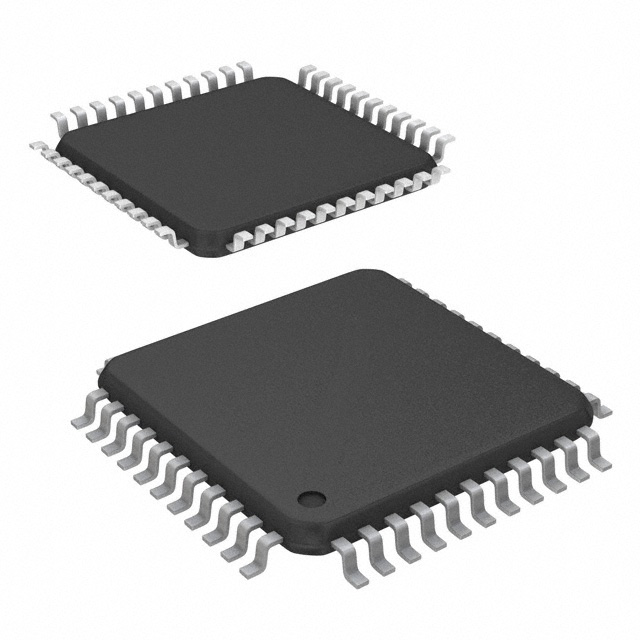T89C51AC2-RLTIM
Product Overview
Category
T89C51AC2-RLTIM belongs to the category of microcontrollers.
Use
This microcontroller is commonly used in various electronic devices and embedded systems for controlling and processing data.
Characteristics
- High-performance 8-bit microcontroller
- Integrated with Flash memory for program storage
- Supports a wide range of input/output interfaces
- Low power consumption
- Reliable and durable
Package
T89C51AC2-RLTIM is available in a compact and industry-standard package, making it suitable for easy integration into different electronic applications.
Essence
The essence of T89C51AC2-RLTIM lies in its ability to provide efficient control and processing capabilities for electronic devices and embedded systems.
Packaging/Quantity
This microcontroller is typically packaged individually or in reels, depending on the manufacturer's specifications. The quantity per package may vary, but it is commonly available in bulk quantities.
Specifications
- Architecture: 8-bit
- CPU Speed: Up to 33 MHz
- Program Memory Size: 64 KB
- RAM Size: 1 KB
- Number of I/O Pins: 32
- Operating Voltage Range: 2.7V to 5.5V
- Communication Interfaces: UART, SPI, I2C
- Timers/Counters: 3
- ADC Channels: 8
- PWM Channels: 4
Detailed Pin Configuration
The pin configuration of T89C51AC2-RLTIM is as follows:
- P0.0 - Port 0, Pin 0
- P0.1 - Port 0, Pin 1
- P0.2 - Port 0, Pin 2
- P0.3 - Port 0, Pin 3
- P0.4 - Port 0, Pin 4
- P0.5 - Port 0, Pin 5
- P0.6 - Port 0, Pin 6
- P0.7 - Port 0, Pin 7
- P1.0 - Port 1, Pin 0
- P1.1 - Port 1, Pin 1
- P1.2 - Port 1, Pin 2
- P1.3 - Port 1, Pin 3
- P1.4 - Port 1, Pin 4
- P1.5 - Port 1, Pin 5
- P1.6 - Port 1, Pin 6
- P1.7 - Port 1, Pin 7
- P2.0 - Port 2, Pin 0
- P2.1 - Port 2, Pin 1
- P2.2 - Port 2, Pin 2
- P2.3 - Port 2, Pin 3
- P2.4 - Port 2, Pin 4
- P2.5 - Port 2, Pin 5
- P2.6 - Port 2, Pin 6
- P2.7 - Port 2, Pin 7
- P3.0 - Port 3, Pin 0
- P3.1 - Port 3, Pin 1
- P3.2 - Port 3, Pin 2
- P3.3 - Port 3, Pin 3
- P3.4 - Port 3, Pin 4
- P3.5 - Port 3, Pin 5
- P3.6 - Port 3, Pin 6
- P3.7 - Port 3, Pin 7
Functional Features
- High-speed processing capabilities
- On-chip Flash memory for program storage
- Multiple communication interfaces for data exchange
- Timers and counters for precise timing operations
- Analog-to-Digital Converter (ADC) for sensor interfacing
- Pulse Width Modulation (PWM) for controlling analog devices
- Interrupt handling for efficient event-driven programming
Advantages and Disadvantages
Advantages
- High-performance microcontroller suitable for various applications
- Low power consumption for energy-efficient designs
- Ample program memory size for complex applications
- Versatile I/O interfaces for flexible connectivity
- Robust and reliable operation
Disadvantages
- Limited RAM size may restrict the complexity of programs
- Lack of advanced features compared to more modern microcontrollers
- Availability and support may vary depending on the manufacturer
Working Principles
T89C51AC2-RLTIM operates based on the principles of a typical microcontroller.
Senaraikan 10 soalan dan jawapan biasa yang berkaitan dengan aplikasi T89C51AC2-RLTIM dalam penyelesaian teknikal
What is the T89C51AC2-RLTIM microcontroller used for?
- The T89C51AC2-RLTIM microcontroller is commonly used in embedded systems for various technical solutions.What are the key features of the T89C51AC2-RLTIM microcontroller?
- The T89C51AC2-RLTIM microcontroller features a high-performance 8-bit CPU, on-chip flash memory, and versatile I/O capabilities.How can the T89C51AC2-RLTIM microcontroller be programmed?
- The T89C51AC2-RLTIM microcontroller can be programmed using various development tools and programming languages such as C or assembly.What are some typical applications of the T89C51AC2-RLTIM microcontroller?
- Typical applications of the T89C51AC2-RLTIM microcontroller include industrial automation, consumer electronics, and automotive systems.Does the T89C51AC2-RLTIM microcontroller support communication interfaces?
- Yes, the T89C51AC2-RLTIM microcontroller supports communication interfaces such as UART, SPI, and I2C for data exchange.Can the T89C51AC2-RLTIM microcontroller interface with external devices?
- Yes, the T89C51AC2-RLTIM microcontroller can interface with external devices through its GPIO pins and communication interfaces.What are the power requirements for the T89C51AC2-RLTIM microcontroller?
- The T89C51AC2-RLTIM microcontroller typically operates at a voltage range of 2.7V to 5.5V with low power consumption.Are there any development kits available for the T89C51AC2-RLTIM microcontroller?
- Yes, there are development kits and evaluation boards available to aid in the development and testing of T89C51AC2-RLTIM-based solutions.Can the T89C51AC2-RLTIM microcontroller be used in real-time applications?
- Yes, the T89C51AC2-RLTIM microcontroller is suitable for real-time applications due to its fast interrupt response and timer capabilities.What are the programming considerations for the T89C51AC2-RLTIM microcontroller?
- When programming the T89C51AC2-RLTIM microcontroller, it's important to consider memory constraints, timing requirements, and efficient code optimization for best performance.


